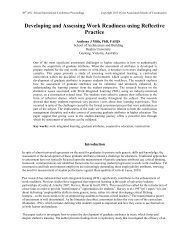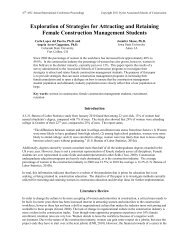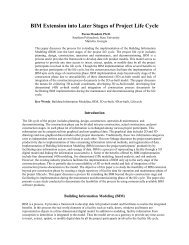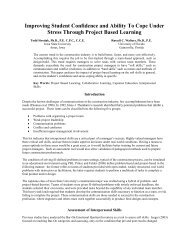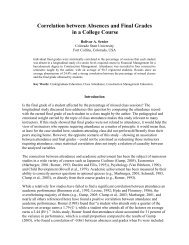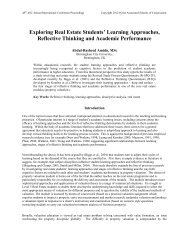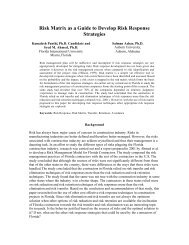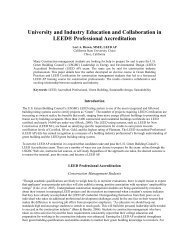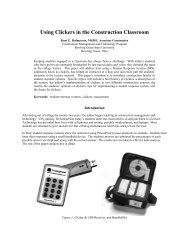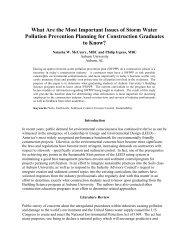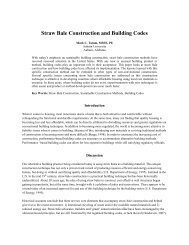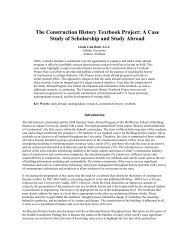Addressing the Issue of Compliance with Personal Protective ...
Addressing the Issue of Compliance with Personal Protective ...
Addressing the Issue of Compliance with Personal Protective ...
You also want an ePaper? Increase the reach of your titles
YUMPU automatically turns print PDFs into web optimized ePapers that Google loves.
<strong>Addressing</strong> <strong>the</strong> <strong>Issue</strong> <strong>of</strong> <strong>Compliance</strong> <strong>with</strong> <strong>Personal</strong> <strong>Protective</strong><br />
Equipment on Construction Worksites: A Workers’<br />
Perspective<br />
Rizwan U. Farooqui, Ph.D. Candidate,<br />
Syed M. Ahmed, Ph.D.,<br />
Kamalesh Panthi, Ph.D. Candidate<br />
Florida International University<br />
Miami, Florida<br />
Salman Azhar, Ph.D.<br />
Auburn University,<br />
Auburn, Alabama<br />
<strong>Personal</strong> <strong>Protective</strong> Equipment (PPE) can be a significant determining factor between an<br />
accident and safety on construction sites. Anecdotal evidence suggests that wearing <strong>the</strong><br />
correct personal protection at all times is extremely important in reducing accidents and<br />
should be given high priority. According to recent statistics by Occupational Safety and<br />
Health Administration (OSHA), only 64% workers, on average, constantly wear <strong>the</strong> correct<br />
protection. The purpose <strong>of</strong> this paper is: (1) to report <strong>the</strong> current workplace PPE issues in <strong>the</strong><br />
construction industry, (2) to investigate <strong>the</strong> causes <strong>of</strong> lack <strong>of</strong> use <strong>of</strong> PPE from a workers‟<br />
perspective, and (3) to recommend solutions to address <strong>the</strong> issue <strong>of</strong> compliance <strong>with</strong> PPE. The<br />
primary data for this research was collected in person via a survey (questionnaire) from site<br />
workers on major building construction sites in South Florida. Data validation was done by<br />
site observation surveys. The major conclusions from <strong>the</strong> study are: Both organizational as<br />
well as worker commitment towards PPE compliance need to be improved. The following<br />
major reasons have been identified for PPE lack <strong>of</strong> usage from workers: uncomfortable/ poor<br />
fit, temperature discomfort/ too hot, reduced productivity/ hinder <strong>the</strong>ir ability to work more<br />
efficiently, not enough PPE for all, not enforced by employer, and lack <strong>of</strong> training on<br />
appropriate use. A major recommendation is that if PPE is to be used consistently as well as<br />
effectively, a PPE program should be implemented. This program should address <strong>the</strong> hazards<br />
present; <strong>the</strong> selection, maintenance, and use <strong>of</strong> PPE; <strong>the</strong> training <strong>of</strong> employees; and<br />
monitoring <strong>of</strong> <strong>the</strong> program to ensure its ongoing effectiveness.<br />
Key Words: PPE, OSHA, Organizational commitment, Employee commitment, <strong>Compliance</strong>.<br />
Introduction<br />
Recent improvements in safety performance have taken place as a combination <strong>of</strong> efforts <strong>of</strong> owners, contractors,<br />
subcontractors, and designers. The owner‟s involvement has shown to favorably influence project safety<br />
performance by setting safety objectives, selecting safe contractors, and participating in safety management during<br />
construction (Huang and Hinze, 2006). Despite <strong>the</strong> dramatic improvements in safety that have taken place in recent<br />
decades, <strong>the</strong> safety record in <strong>the</strong> construction industry continues to be one <strong>of</strong> <strong>the</strong> poorest (Huang and Hinze, 2006)<br />
and <strong>the</strong> industry is consistently ranked among <strong>the</strong> most dangerous occupations accounting for a disproportionately<br />
large percentage <strong>of</strong> all work-related illnesses, injuries, and deaths in <strong>the</strong> United States (Center to Protect Workers‟<br />
Rights, 2005). According to <strong>the</strong> National Safety Council, <strong>the</strong> economic impact <strong>of</strong> fatal and nonfatal injuries<br />
amounted to $625.5 billion in 2005 (NSC, 2005)! Construction related injuries representing a substantial chunk <strong>of</strong><br />
that number. The U.S. Bureau <strong>of</strong> Labor Statistics (2005) shows that construction‟s overall lost-days nonfatal<br />
occupational injury and illness incidences rate (239.5 cases per 10,000 full-time workers) has been higher than any<br />
o<strong>the</strong>r industry sector.
Organizations can improve safety by providing <strong>the</strong> necessary systems, tools and motivation. However, safety is<br />
implemented, in essence, by construction workers on work sites who indeed need to adopt adequate safety related<br />
tools, equipment and systems for <strong>the</strong> provision and control <strong>of</strong> work environment and human behavior (Farooqui et<br />
al, 2007). <strong>Personal</strong> <strong>Protective</strong> Equipment (PPE) is a key to personal safety at <strong>the</strong> worker level. Often overlooked and<br />
mostly considered as being only a minor player in <strong>the</strong> overall site safety, PPE can be a significant determining factor<br />
between an accident and safety. Anecdotal evidence suggests that wearing <strong>the</strong> correct personal protection at all times<br />
is extremely important in reducing accidents and should be given high priority. This is not to assert <strong>of</strong> course that<br />
safe work practices should be given any lesser priority.<br />
Occupational Safety and Health Administration (OSHA) – <strong>the</strong> organization responsible for outlining safety policies<br />
and procedures, requires <strong>the</strong> use <strong>of</strong> PPE to reduce employee exposure to hazards when engineering and<br />
administrative controls are not feasible or effective in reducing <strong>the</strong>se exposures to acceptable levels. Employers are<br />
required to determine if PPE should be used to protect <strong>the</strong>ir workers. The above OSHA policy somehow undermines<br />
<strong>the</strong> significance <strong>of</strong> PPE and lets <strong>the</strong> employers be <strong>the</strong> judge. This aspect has proven to be detrimental to safety in a<br />
number <strong>of</strong> cases when <strong>the</strong> workers have not been found wearing <strong>the</strong> required appropriate PPE and as a result<br />
suffering from accident. This is evident from <strong>the</strong> literature review and surveys conducted under this study (related in<br />
subsequent sections).<br />
The purpose <strong>of</strong> this paper is three fold: (1) to report <strong>the</strong> current workplace PPE issues in <strong>the</strong> construction industry,<br />
(2) to investigate <strong>the</strong> causes <strong>of</strong> lack <strong>of</strong> use <strong>of</strong> PPE from workers perspective, and (3) to recommend solutions to<br />
address <strong>the</strong> issue <strong>of</strong> compliance <strong>with</strong> PPE.<br />
Research Objectives and Methodology<br />
The main objective <strong>of</strong> <strong>the</strong> research is to investigate <strong>the</strong> causes <strong>of</strong> non-use/ lack <strong>of</strong> use <strong>of</strong> PPE. A secondary objective<br />
is to look for possible solutions. The scope <strong>of</strong> <strong>the</strong> research is limited to collecting and analyzing <strong>the</strong> data from <strong>the</strong><br />
perspective <strong>of</strong> construction workers. It is expected that <strong>the</strong> findings will aid in 1) identifying <strong>the</strong> root causes <strong>of</strong> lack<br />
<strong>of</strong> usage <strong>of</strong> PPE, and 2) developing strategies for improved PPE usage and hence improved safety performance.<br />
To achieve <strong>the</strong> study objectives, <strong>the</strong> following research methodology was adopted. The study first developed <strong>the</strong><br />
rationale <strong>of</strong> <strong>the</strong> need <strong>of</strong> PPE in <strong>the</strong> construction industry. This was done by critically evaluating <strong>the</strong> cost<br />
consequences <strong>of</strong> lack <strong>of</strong> use <strong>of</strong> PPE. This research was conducted through many different sources: books, electronic<br />
copies <strong>of</strong> books, scholarly journals articles, magazines, abstracts from safety conferences, safety databases, and<br />
websites. Following this, a questionnaire was developed for assessing issues related to PPE compliance, provision,<br />
and use. The questionnaire was used to collect data from construction site workers on major building construction<br />
sites in South Florida. Data validation was done by site observation surveys. Finally, <strong>the</strong> data was compiled,<br />
analyzed and conclusions drawn. Subsequent sections have been laid out appropriately to depict <strong>the</strong> methodology.<br />
Need for PPE: Cost <strong>of</strong> PPE Non-<strong>Compliance</strong><br />
The Bureau <strong>of</strong> Labor Statistics (BLS) concludes that in <strong>the</strong> year 2006, <strong>the</strong> American construction sector was<br />
responsible for 21% (1226 in count) <strong>of</strong> all workplace fatalities across all industries, and 10.4% (412,900 in count) <strong>of</strong><br />
all <strong>the</strong> country‟s nonfatal occupational injuries and illnesses.<br />
Research shows that <strong>the</strong> major causes <strong>of</strong> construction accidents are related to human behavior, difficult work site<br />
conditions, inadequate use <strong>of</strong> protective equipment, and poor safety management, which result in unsafe work<br />
methods, equipment and procedures (Abdelhamid and Everett, 2000). In a recent survey by <strong>the</strong> Laborers‟ Health<br />
and Safety Fund <strong>of</strong> North America (2006), 40 percent <strong>of</strong> construction workers said “working while hurt” is a major<br />
problem. Many <strong>of</strong> <strong>the</strong> injuries that occur in <strong>the</strong> construction industry are due to <strong>the</strong> manual material handling that is<br />
required in <strong>the</strong> construction industry (The Eastman Kodak Company, 2004). As pointed by <strong>the</strong> U.S. National<br />
Institute for Occupational Safety and Health (NIOSH), material handling incidents account for 32% <strong>of</strong> workers‟<br />
compensation claims in construction, and 25% <strong>of</strong> <strong>the</strong> cost <strong>of</strong> all claims (NIOSH, 2007). Use <strong>of</strong> appropriate PPE in a<br />
timely manner should help improve <strong>the</strong> safety scenario.
PPE refers to protective clothing, helmets, goggles, or o<strong>the</strong>r garment designed to protect <strong>the</strong> wearer's body or<br />
clothing from injury by electrical hazards, heat, chemicals, and infection, for job-related occupational safety and<br />
health purposes, and in sports, martial arts, combat, etc. There are different types <strong>of</strong> PPE related to construction. The<br />
most common being head, hand, face, eye, foot, and body protection.<br />
To protect from head and neck injuries, a hard hat is required to be used. Road construction companies alone in <strong>the</strong><br />
U.S. pay out approximately 19 million dollars more for head and neck injuries each year than it cost <strong>the</strong>m to equip<br />
<strong>the</strong> entire workforce <strong>with</strong> hard hats (ISEA, 2008). Even though head protection may not protect from every potential<br />
blow, it can greatly reduce head injuries. High visibility apparel is ano<strong>the</strong>r form <strong>of</strong> PPE that <strong>of</strong>tentimes is not<br />
exercised fully. Approximately 65 million dollars (ISEA, 2005) are spent on related injuries in roadway construction<br />
in U.S. Measures have been taken to enforce speed limits at work zones and to raise awareness among construction<br />
workers, but wearing appropriate apparel should not be underestimated.<br />
Ano<strong>the</strong>r common malpractice in relation to PPE is <strong>the</strong> lack <strong>of</strong> use <strong>of</strong> hearing protection when needed. It‟s common<br />
to observe construction workers wearing <strong>the</strong>ir hard hats, appropriate boots and gloves but no hearing protection<br />
around noisy operations. Hearing loss injuries are responsible for 14 million dollars spent each year (ISEA, 2007).<br />
“We believe that wearing today‟s high performance, comfortable hearing protectors; earmuffs as well as reusable<br />
earplugs, will protect against a vast majority <strong>of</strong> hearing loss injuries, adding immeasurable quality <strong>of</strong> life for those<br />
who use <strong>the</strong>m regularly and <strong>the</strong>ir families over <strong>the</strong> course <strong>of</strong> a career” observed by <strong>the</strong> president <strong>of</strong> a major<br />
construction firm in South Florida.<br />
Something as trivial as not putting on a pair <strong>of</strong> proper gloves is responsible for 48 million dollars each year (ISEA,<br />
2006)! It is amazing how easy it is to put a pair <strong>of</strong> gloves on and yet workers have a difficult time doing so. Foot<br />
protection is ano<strong>the</strong>r one that requires little to no effort. A pair <strong>of</strong> qualified boots is more than enough to reduce <strong>the</strong><br />
chance <strong>of</strong> a foot related injury. It does not take much effort to wear <strong>the</strong> appropriate PPE when working, but still,<br />
only 64% workers, on average, constantly wear <strong>the</strong> correct protection (OSHA, 2007).<br />
Observing <strong>the</strong> above data, it can be concluded that adequate, timely and appropriate use <strong>of</strong> PPE is essential as well<br />
can be can contribute extensively to improving <strong>the</strong> safety performance <strong>of</strong> <strong>the</strong> industry. Hence this is an aspect that<br />
requires fur<strong>the</strong>r insight, especially as to why an appreciable proportion <strong>of</strong> construction workers do not wear PPE.<br />
This diagnosis will be significant, in particular, towards developing strategic recommendations for improved usage<br />
<strong>of</strong> PPE in <strong>the</strong> industry. The research in hand aspires to do that.<br />
Research Design and Methods<br />
Following <strong>the</strong> literature review, a survey was designed <strong>with</strong> <strong>the</strong> objective to know directly from <strong>the</strong> people, who use<br />
<strong>the</strong> PPE more <strong>of</strong>ten, i.e. <strong>the</strong> construction workers, <strong>the</strong>ir perception, experience, and inputs on why usage <strong>of</strong> PPE is<br />
not working at its full extent in <strong>the</strong> industry. The questionnaire contained fifteen (15) questions grouped into four<br />
sections. The description <strong>of</strong> <strong>the</strong>se sections is as follows; Section 1: background information about <strong>the</strong> respondent and<br />
<strong>the</strong> organization; Section 2: Management commitment towards PPE; Section 3: Worker responsibility and<br />
involvement towards PPE; and Section 4: Usage <strong>of</strong> PPE/ Understanding <strong>the</strong> <strong>Issue</strong>s <strong>with</strong> PPE.<br />
The primary data for this research was collected in person from site workers from twelve (12) work sites in South<br />
Florida. The research required <strong>the</strong> assistance <strong>of</strong> contractor management who provided <strong>the</strong>ir meeting rooms for<br />
worker attendance. The content <strong>of</strong> <strong>the</strong> questionnaire was explained to <strong>the</strong> construction workers in order to increase<br />
workers' understanding before filling in <strong>the</strong> questionnaire. The time for questionnaire filling was approximately 20<br />
minutes. The questionnaires were collected after <strong>the</strong> workers duly completed <strong>the</strong>m. Discussion <strong>with</strong> <strong>the</strong> workers was<br />
also done in order to better understand <strong>the</strong> issues and recommend possible solutions. Site observation was<br />
conducted on three (3) selected construction sites to verify <strong>the</strong> validity <strong>of</strong> <strong>the</strong> data collection. The observations were<br />
made on half day visits to each worksite. Based on <strong>the</strong> ga<strong>the</strong>red information, quantitative analysis was performed<br />
and <strong>the</strong> results are discussed in <strong>the</strong> following section.
Analysis <strong>of</strong> Results and Discussion<br />
Fifty four (54) copies <strong>of</strong> <strong>the</strong> questionnaire were distributed to <strong>the</strong> construction workers on <strong>the</strong> twelve (12) work sites.<br />
The response was highly encouraging and forty eight (48) copies <strong>of</strong> questionnaires were returned (mostly on site)<br />
complete. The return rate was 88.9%. Two (2) responses were invalid owing to inconsistency in <strong>the</strong> responses and<br />
were discarded. The remaining forty six (46) responses were included in <strong>the</strong> analysis and provided useful<br />
information for <strong>the</strong> survey.<br />
The following sub-sections illustrate <strong>the</strong> major findings. In line <strong>with</strong> <strong>the</strong> format <strong>of</strong> <strong>the</strong> questionnaire, <strong>the</strong> results are<br />
reported in four sections. The workers‟ responses are indicated as a percentage <strong>of</strong> total responses.<br />
Section 1(a): Responding Organizations Characteristics<br />
Of <strong>the</strong> fourteen (14) construction companies asked to participate, nine (9) responded to <strong>the</strong> opportunity. This<br />
represents a response rate <strong>of</strong> 64.3%. The size <strong>of</strong> <strong>the</strong> participating companies was medium to large, <strong>with</strong> some<br />
employing as few as 1000 workers, and o<strong>the</strong>rs as many as 3000 workers. The workforce and type <strong>of</strong> work <strong>of</strong><br />
participating construction firms was primarily general building construction. The participating firms were primarily<br />
from South Florida. The average time that <strong>the</strong> companies had been in business was 22 years. Looking at <strong>the</strong> gender<br />
distribution <strong>of</strong> <strong>the</strong> companies surveyed, <strong>the</strong> percentage <strong>of</strong> male employees had a wide margin over female<br />
employees. The women population represented 3% <strong>of</strong> <strong>the</strong> total number <strong>of</strong> workers responding.<br />
Section 1(b): Respondent (Workers) Pr<strong>of</strong>ile<br />
There were 82.5% <strong>of</strong> <strong>the</strong> construction workers over <strong>the</strong> age <strong>of</strong> 35 years. There were 27% <strong>of</strong> <strong>the</strong> construction workers<br />
who had worked less than 5 years on construction sites and 32 % <strong>of</strong> <strong>the</strong>m had between 6 to 10 years <strong>of</strong> work<br />
experience. 8% <strong>of</strong> <strong>the</strong> construction workers surveyed were female workers. Table 1 summarizes <strong>the</strong> nature <strong>of</strong> project<br />
sites <strong>the</strong> workers were associated <strong>with</strong>, when surveyed.<br />
Table 1<br />
Respondent (Workers) Project Share<br />
Respondent Share (No. <strong>of</strong> responding workers)<br />
Project Type<br />
Office Shopping<br />
Total<br />
Condominiums<br />
Schools Hospitals<br />
Buildings Malls<br />
(%)<br />
Mason 2 1 1 1 0 10.87<br />
Carpenter 0 1 1 1 1 8.70<br />
Electrician 1 0 1 0 1 6.52<br />
Plumber 0 1 1 0 1 6.52<br />
Framer 1 1 1 1 0 8.70<br />
Welder 1 0 1 1 0 6.52<br />
Steel Fixer 0 1 0 1 1 6.52<br />
Laborer 1 1 0 1 1 8.70<br />
Crane Operator 0 1 0 1 0 4.35<br />
Heavy Equipment Operator 1 1 0 0 0 4.35<br />
Painter 0 1 1 1 0 6.52<br />
Ro<strong>of</strong>er 1 0 1 0 1 6.52<br />
Cement Finisher 0 1 1 0 0 4.35<br />
Cladding Fixer 1 0 0 1 0 4.35<br />
HVAC Fixer 0 1 1 1 0 6.52<br />
Total (%) 19.57 23.91 21.74 21.74 13.04<br />
Section 2: Management Commitment towards PPE
In this section, six (6) questions were asked to evaluate contractor management‟s commitment towards PPE. The<br />
results are as follows.<br />
1. Does management indicate <strong>the</strong> statutory requirements for <strong>the</strong> provision <strong>of</strong> PPE in its site safety plan? (Yes/ No/<br />
Can’t Say)<br />
80% responded in affirmation. However, it is interesting to note that workers from 14% <strong>of</strong> <strong>the</strong> contracting<br />
organizations surveyed claimed that <strong>the</strong>ir management does not include provision <strong>of</strong> PPE as part <strong>of</strong> its safety<br />
commitment in <strong>the</strong>ir site safety plans. Although <strong>the</strong> proportion is low, it is quite alarming because this clearly<br />
indicates that some organizations do not have a strong commitment to worker safety in terms <strong>of</strong> defining <strong>the</strong><br />
appropriate policies for provision <strong>of</strong> PPE. A few workers (3 workers i.e. 6%) indicated that <strong>the</strong>y do not have an idea<br />
whe<strong>the</strong>r provision <strong>of</strong> PPE is an explicit requirement in <strong>the</strong> site safety plan or not. This ei<strong>the</strong>r reflects a lack <strong>of</strong><br />
worker commitment to understanding and acting on site safety procedures, or a lack <strong>of</strong> management commitment to<br />
appropriately communicate <strong>the</strong> site safety plan to <strong>the</strong>ir workforce.<br />
2. Does management maintain PPE facilities on worksites (whe<strong>the</strong>r adequate or inadequate)?<br />
(Always/ Often/ Occasionally/ No)<br />
Results indicate that contractor management generally strives to maintain PPE facilities on worksites in most <strong>of</strong> <strong>the</strong><br />
cases (62%). This is a positive finding as to a general sense <strong>of</strong> contractor management commitment to PPE.<br />
However, it is important to note that almost 40% <strong>of</strong> <strong>the</strong> contractors do not consider maintaining PPE on worksites as<br />
<strong>the</strong>ir top most priority (26% do it <strong>of</strong>ten while 12% only do it occasionally) and <strong>the</strong>re may be times in <strong>the</strong>ir projects<br />
where <strong>the</strong> required PPE is not available to <strong>the</strong> workers.<br />
3. Does management obtain a sufficient stock <strong>of</strong> carefully selected and appropriate PPE for each site? (Always/<br />
Often/ Occasionally/ No)<br />
Results depict some interesting findings. Compared <strong>with</strong> <strong>the</strong> responses obtained for <strong>the</strong> extent <strong>of</strong> management<br />
commitment to maintaining PPE facilities on worksites (previous question), it is evident from above results that,<br />
amongst <strong>the</strong> contractors striving to maintain PPE facilities on worksites, a smaller proportion <strong>of</strong> contractors strive to<br />
ensure sufficiency and appropriateness <strong>of</strong> <strong>the</strong>ir PPE. For instance, 62% contractors put efforts to always maintaining<br />
PPE facilities on worksites but only 48% strive to make sure that <strong>the</strong> stock is adequate as well as appropriate.<br />
Moreover, even though all contractors maintain some kind <strong>of</strong> PPE support on worksites, 12% do not extend any<br />
efforts to ensuring <strong>the</strong> sufficiency and appropriateness <strong>of</strong> <strong>the</strong> equipment; while ano<strong>the</strong>r 18% only extend this effort<br />
occasionally (<strong>the</strong> remaining 22% do it <strong>of</strong>ten). These results indicate a lack <strong>of</strong> management commitment towards PPE<br />
from an appreciable proportion <strong>of</strong> contractor organizations.<br />
4. Has management established an effective system for <strong>the</strong> issuance, recording and inspection <strong>of</strong> PPE and its<br />
replacement? (Yes/ No)<br />
68% workers responded affirmatively to this question. This indicates that almost one-third proportion <strong>of</strong> contracting<br />
organizations do not have adequate PPE management systems. Hence it is highly likely that <strong>the</strong> associated<br />
workforce, owing to inadequate and/ or inappropriate PPE, may be exposed to safety hazards. Moreover, this also<br />
indicates that almost one-third organizations lack a mechanism to inspect <strong>the</strong> appropriate use <strong>of</strong> PPE by <strong>the</strong>ir<br />
workers. This fact may allow many workers to work on site <strong>with</strong>out having <strong>the</strong> necessary safety equipment on, and<br />
this may go as an acceptable worker behavior from <strong>the</strong> perspective <strong>of</strong> top management.<br />
5. Does your company provide training on <strong>the</strong> use <strong>of</strong> PPE? (Yes/ No)<br />
76% workers responded affirmatively to this question. This indicates that almost 25% contracting organizations do<br />
not provide PPE related training. Hence it is highly likely that <strong>the</strong> associated workforce, owing to inadequate<br />
training on PPE use, may be exposed to safety hazards. Moreover, this also indicates that almost 25% organizations<br />
lack a mechanism to develop a PPE culture amongst <strong>the</strong>ir workers. This fact, in particular, indicates management‟s<br />
lack <strong>of</strong> commitment to PPE in almost one-quarter <strong>of</strong> <strong>the</strong> organizations.<br />
6. Is <strong>the</strong>re a procedure to monitor <strong>the</strong> PPE brought on-site by subcontractor workers? (Yes/ No)
62% workers responded affirmatively to this question. This indicates that almost 40% contracting organizations do<br />
not monitor <strong>the</strong> PPE brought-in by <strong>the</strong>ir subcontractors. This indicates a lack <strong>of</strong> PPE policy from <strong>the</strong> contractors in<br />
terms <strong>of</strong> mandating <strong>the</strong> use <strong>of</strong> PPE on <strong>the</strong>ir worksites. Moreover, this also indicates that almost 40% organizations<br />
lack a mechanism to inculcate a PPE culture on <strong>the</strong>ir worksites. This fact, in particular, indicates management‟s lack<br />
<strong>of</strong> commitment to PPE in almost 40% organizations.<br />
Section 3: Worker Responsibility and Involvement towards PPE<br />
In this section, three (3) questions were asked to assess <strong>the</strong> extent <strong>of</strong> worker responsibility towards compliance and<br />
wearing PPE as well as <strong>the</strong>ir level <strong>of</strong> involvement in <strong>the</strong> selection and purchase processes for PPE. The results are as<br />
follows.<br />
7. Do you feel you have a responsibility for compliance <strong>with</strong> PPE?(Major/ Minor/ Not Sure)<br />
78% workers indicated that <strong>the</strong>y have a major responsibility for compliance <strong>with</strong> PPE; 6% were convinced that it is<br />
not <strong>the</strong>ir major responsibility but ra<strong>the</strong>r <strong>the</strong> responsibility <strong>of</strong> <strong>the</strong> management to comply <strong>with</strong> PPE procedures; while<br />
<strong>the</strong> remaining 16% were not sure. The above results indicate a lack <strong>of</strong> consensus as well as poor attitude from about<br />
20% workers as to accepting <strong>the</strong> responsibility for PPE compliance, which is indeed a major consequence <strong>of</strong> lack <strong>of</strong><br />
management commitment and emphasis towards PPE.<br />
8. Do you feel you have a responsibility for wearing PPE at all times?(Yes/ No)<br />
Although 100% contractors provide some kind <strong>of</strong> PPE facilities on worksites, 38% <strong>of</strong> construction workers were not<br />
sure whe<strong>the</strong>r <strong>the</strong>y have to wear protective equipment on <strong>the</strong> construction sites at all times. This reflects a lack <strong>of</strong><br />
awareness and training as to <strong>the</strong> need, significance and responsibility towards wearing PPE.<br />
9. Are you responsible for purchasing, selecting, influencing <strong>the</strong> purchase or selection <strong>of</strong> PPE? (Yes/ No)<br />
Only thirty percent (35%) reflected that <strong>the</strong>y had a role in influencing <strong>the</strong> purchase and selection <strong>of</strong> PPE. This<br />
reflects both <strong>the</strong> management lack <strong>of</strong> commitment towards involving workers in <strong>the</strong> PPE decision making process,<br />
as well workers‟ inappropriate attitude towards being involved in <strong>the</strong> PPE selection and procurement process.<br />
10. Do you ask your supervisors for provision <strong>of</strong> appropriate and adequate PPE when not provided? (Yes/ No)<br />
The survey revealed that 28% <strong>of</strong> <strong>the</strong> workers would not ask <strong>the</strong>ir contractor supervisors for provision <strong>of</strong> PPE (if not<br />
provided) because <strong>the</strong>y were ei<strong>the</strong>r not feeling <strong>the</strong> responsibility for compliance <strong>with</strong> PPE or were mobilized<br />
workers employed by subcontractors working on temporary basis.<br />
Section 4: Usage <strong>of</strong> PPE/ Understanding <strong>the</strong> <strong>Issue</strong>s <strong>with</strong> PPE<br />
In this section, six (6) questions were asked to assess <strong>the</strong> extent <strong>of</strong> usage <strong>of</strong> PPE on work sites and to understand <strong>the</strong><br />
issues <strong>with</strong> PPE lack <strong>of</strong> usage. The results are as follows.<br />
11. Have you ever observed anyone in your organization failing to wear proper PPE in a situation when <strong>the</strong>y<br />
should have been wearing it?(Yes/ No)<br />
Alarmingly, 53% workers responded affirmatively. This indicates that in almost 50% <strong>of</strong> <strong>the</strong> organizations, failing to<br />
wear PPE when required is an acceptable behavior.<br />
12. If you answered “Yes” to <strong>the</strong> previous question, was it investigated by management at anytime as to why<br />
wearing <strong>of</strong> PPE was not observed?(Yes/ No)<br />
Out <strong>of</strong> <strong>the</strong> 53% workers who responded affirmatively to <strong>the</strong> previous question, only 28% indicated that it was<br />
investigated by management as to why wearing <strong>of</strong> PPE was not observed. This indicates a lack <strong>of</strong> PPE control<br />
mechanism in almost 25% <strong>of</strong> <strong>the</strong> organizations.
13. Do you personally believe that wearing PPE can help you protect from work related injuries?(Yes/ No)<br />
82% <strong>of</strong> <strong>the</strong> workers believed that wearing PPE can protect <strong>the</strong>m from work injuries and that in addition to being a<br />
safety requirement, wearing PPE is as well a legal requirement.<br />
14. Do you wear PPE as a habitual inclination? (Yes/ No)<br />
58% workers were reluctant to wear protective equipment.<br />
Discussion on Reasons for not Wearing PPE: Workers’ Perspective<br />
When diagnosed for <strong>the</strong> Reasons for not Wearing PPE, <strong>the</strong> reasons ranged anywhere from “I don‟t know” to “I<br />
didn‟t think I needed it”. Based on <strong>the</strong> findings <strong>of</strong> <strong>the</strong> study, <strong>the</strong> researchers were able to compile a general<br />
consensus as to <strong>the</strong> reasons for not wearing PPE.<br />
The number one reason why workers do not like to use PPE all <strong>the</strong> time is because it is flat out uncomfortable or<br />
does not fit right (58%). Having to work for 8 to 10 hours a day <strong>with</strong> something on that is not comfortable can take a<br />
toll on anybody and force <strong>the</strong>m to take it <strong>of</strong>f. When asked about exposing oneself to safety risk versus being<br />
comfortable, a worker commented, “I know that by taking my hat <strong>of</strong>f I will be at a higher risk, but I would ra<strong>the</strong>r be<br />
<strong>the</strong>re than uncomfortable for 8 hours.” The same reason for not wearing PPE came from <strong>the</strong> women workers as well.<br />
Although more and more women are taking on jobs that traditionally only men used to do, in <strong>the</strong> case <strong>of</strong><br />
construction, this creates an issue because most <strong>of</strong> <strong>the</strong> safety equipment is tailor made to fit men and not women.<br />
They become frustrated that <strong>the</strong>y cannot find something to fit <strong>the</strong>m right, so <strong>the</strong>y don‟t wear any protective<br />
equipment at all, hence increasing <strong>the</strong> risk <strong>of</strong> injury.<br />
The workers also complained facing stress problem in wearing PPE particularly in hot, sunny wea<strong>the</strong>r, confined and<br />
poor ventilated areas (38%). Reduced work productivity, i.e. hindrance in ability to work more efficiently was also<br />
indicated a major reason for lack <strong>of</strong> use <strong>of</strong> PPE by <strong>the</strong> workers (34%).<br />
Ano<strong>the</strong>r common response was that PPE was ei<strong>the</strong>r not available in ample quantity for all (24%) or was not<br />
enforced by <strong>the</strong> employer (18%). The latter is a little more disturbing because as a construction contractor as well as<br />
an employer, <strong>the</strong>y should know better. Not only should <strong>the</strong> employer care for <strong>the</strong> well being <strong>of</strong> its employees but it<br />
is always more pr<strong>of</strong>itable to invest a little money into a safety program. In addition to not enforcing <strong>the</strong> use <strong>of</strong> PPE,<br />
employers also fail to make PPE easily accessible. Few workers noted that even though <strong>the</strong> employer tells <strong>the</strong>m to<br />
wear <strong>the</strong>ir safety equipment and <strong>the</strong> workers want to wear it, sometimes <strong>the</strong>re just isn‟t enough for everybody. This<br />
discourages <strong>the</strong> use because workers do not feel like fighting for PPE.<br />
Few responses revealed that workers have not received training on <strong>the</strong> use <strong>of</strong> protection equipment (18%). This<br />
indicates lack <strong>of</strong> management commitment towards PPE enforcement. O<strong>the</strong>r workers indicated that <strong>the</strong>y have not<br />
accustomed <strong>the</strong>mselves to wearing protective equipment during work operation (14%). There are o<strong>the</strong>r minor<br />
reasons workers don‟t wear <strong>the</strong>ir PPE, some <strong>of</strong> which include PPE not easily accessible from site <strong>of</strong> work task<br />
(12%), looking ridiculous <strong>with</strong> it on (8%), and not knowing it was necessary at <strong>the</strong> time (6%).<br />
As a consequence to <strong>the</strong> above reasons, <strong>the</strong> statistic is that only around 65% <strong>of</strong> <strong>the</strong> time workers really are using<br />
<strong>the</strong>ir needed personal protection (OSHA, 2007). This is a staggering statistic that needs to be changed. Solutions to<br />
this problem can start by focusing on <strong>the</strong> major reasons why workers take PPE <strong>of</strong>f: <strong>the</strong> top on <strong>the</strong> list being making<br />
<strong>the</strong> PPE more comfortable. Also, new innovative ways to get <strong>the</strong>m to put it on should also be welcome.<br />
Site Observation<br />
To validate some <strong>of</strong> <strong>the</strong> survey findings, site observation was conducted on two construction sites. It was observed<br />
that while most <strong>of</strong> <strong>the</strong> workers were wearing appropriate PPE, few workers were an exception. For example, on one
site, few workers carried out breaking concrete work <strong>with</strong>out wearing earplugs. It was ironic that nei<strong>the</strong>r any <strong>of</strong> <strong>the</strong><br />
on-site contractor supervisors nor safety <strong>of</strong>ficers stopped <strong>the</strong> workers from performing <strong>the</strong> unsafe behavior.<br />
It was observed that few workers on construction sites were reluctant to use personal protective equipment, despite<br />
<strong>the</strong> law requirement imposed on construction sites. On some sites, <strong>the</strong>re were ample personal protective equipment<br />
provided, such as hardhats, protective gloves, goggles, masks and protective hearing equipment. Never<strong>the</strong>less, few<br />
workers (almost 25%) on <strong>the</strong> construction sites failed to wear <strong>the</strong>se safety gadgets.<br />
Conclusions<br />
Organizational commitment towards PPE compliance needs to be improved. This is evident from a number <strong>of</strong><br />
findings: 1) 14% <strong>of</strong> <strong>the</strong> contracting organizations surveyed do not include provision <strong>of</strong> PPE as part <strong>of</strong> its safety<br />
commitment in <strong>the</strong>ir site safety plans; 2) 40% <strong>of</strong> <strong>the</strong> contractors do not consider maintaining PPE on worksites as<br />
<strong>the</strong>ir top most priority and <strong>the</strong>re may be times in <strong>the</strong>ir projects where <strong>the</strong> required PPE is not available to <strong>the</strong><br />
workers; 3) 12% contractors do not extend any efforts to ensuring <strong>the</strong> sufficiency and appropriateness <strong>of</strong> <strong>the</strong><br />
equipment; 4) A one-third proportion <strong>of</strong> contracting organizations do not have adequate PPE management systems;<br />
5) A one-fourth proportion <strong>of</strong> contracting organizations do not provide PPE related training; 6) 40% contracting<br />
organizations do not monitor <strong>the</strong> PPE brought-in by <strong>the</strong>ir subcontractors.<br />
Worker commitment towards PPE usage also needs to be improved. This is evident from a number <strong>of</strong> findings: 1)<br />
Although 100% contractors provide some kind <strong>of</strong> PPE facilities on worksites, 38% construction workers were not<br />
sure whe<strong>the</strong>r <strong>the</strong>y have to wear protective equipment on <strong>the</strong> construction sites at all times; 2) Only 35% workers<br />
reflected that <strong>the</strong>y had a role in influencing <strong>the</strong> purchase and selection <strong>of</strong> PPE. This reflects both <strong>the</strong> management<br />
lack <strong>of</strong> commitment towards involving workers in <strong>the</strong> PPE decision making process, as well workers‟ inappropriate<br />
attitude towards being involved in <strong>the</strong> PPE selection and procurement process; 3) 28% workers would not ask <strong>the</strong>ir<br />
contractor supervisors for provision <strong>of</strong> PPE (if not provided) because <strong>the</strong>y were ei<strong>the</strong>r not feeling <strong>the</strong> responsibility<br />
for compliance <strong>with</strong> PPE or were mobilized workers employed by subcontractors working on temporary basis.<br />
The following major reasons have been identified for PPE lack <strong>of</strong> usage from workers, in descending order <strong>of</strong><br />
criticality: 1) Uncomfortable/ Poor Fit, 2) Temperature discomfort, 3) Reduced productivity/ Hinder ability to work<br />
more efficiently, 4) Not enough PPE, 5) Not enforced by employer, and 6) Lack <strong>of</strong> training on appropriate use.<br />
<strong>Addressing</strong> <strong>the</strong> <strong>Issue</strong> <strong>of</strong> <strong>Compliance</strong> <strong>with</strong> PPE – Recommendations on Possible Solutions<br />
After ga<strong>the</strong>ring information from individuals regarding <strong>the</strong> use <strong>of</strong> personal protective equipment, and noting <strong>the</strong><br />
commonalities associated <strong>with</strong> <strong>the</strong>ir responses as well as conducting site observations, <strong>the</strong> research team came up<br />
<strong>with</strong> some recommendations for addressing <strong>the</strong> compliance issues <strong>with</strong> PPE.<br />
In an attempt to make <strong>the</strong> use <strong>of</strong> PPE more widely spread, an important suggestion would be to improve <strong>the</strong> level <strong>of</strong><br />
comfort experienced when <strong>the</strong> PPE is being used. Comfort was an issue <strong>with</strong> many workers and can be addressed in<br />
a variety <strong>of</strong> ways:<br />
1. A workers dexterity while working <strong>with</strong> tools and handling materials is important, and many complained <strong>of</strong><br />
<strong>the</strong> bulkiness experienced when using large gloves. Available on <strong>the</strong> market are much smaller and form<br />
fitting gloves that provide both protection and a better fit.<br />
2. Ano<strong>the</strong>r issue was <strong>the</strong> workers concern for temperature. Solutions available include fabrics that are made<br />
from lighter materials and that enable to brea<strong>the</strong> more readily.<br />
3. Head protection in <strong>the</strong> form <strong>of</strong> hard hats also received a bit <strong>of</strong> criticism. Some felt as though <strong>the</strong> head dress<br />
made <strong>the</strong>m appear silly along <strong>with</strong> some discomfort when worn for long periods <strong>of</strong> time. Though a bit more<br />
expensive hard hats are available <strong>with</strong> a higher quality interior web and padding that would make <strong>the</strong><br />
experience more tolerable. As far as <strong>the</strong>ir concern for how <strong>the</strong>y looked, <strong>the</strong> group noted many different<br />
styles <strong>of</strong> hard hats ranging from those that took <strong>the</strong> form <strong>of</strong> a cowboy hat to those <strong>with</strong> pr<strong>of</strong>essional team
logos. Allowing <strong>the</strong> employee to choose <strong>the</strong>ir style can give <strong>the</strong> employee <strong>the</strong> opportunity to express <strong>the</strong>ir<br />
individuality and personal taste, providing <strong>the</strong>m <strong>with</strong> a feeling <strong>of</strong> appearing more stylish.<br />
A reward or incentive program to <strong>the</strong> employees for consciously making an honest effort to wear <strong>the</strong>ir PPE can be<br />
ano<strong>the</strong>r solution. Rewards would include a monetary gift or bonus added to <strong>the</strong>ir regular check for wearing <strong>the</strong>ir<br />
PPE or added time to <strong>the</strong>ir regularly scheduled vacation, while incentives might include a raise that would increase<br />
<strong>the</strong>ir weekly salary.<br />
Training is ano<strong>the</strong>r method <strong>of</strong> communicating <strong>the</strong> importance <strong>of</strong> safety to <strong>the</strong> employee. Safety training on <strong>the</strong> use <strong>of</strong><br />
protective equipment should be conducted to <strong>the</strong> construction workers. The employer should not only provide <strong>the</strong><br />
time and subject matter <strong>of</strong> <strong>the</strong> training but somehow should create an environment conducive to learning. The<br />
training program should include <strong>the</strong> application <strong>of</strong> PPE, its standard, suitability, and comfort to <strong>the</strong> workers. The<br />
workers should also learn PPE maintenance as part <strong>of</strong> <strong>the</strong>ir training.<br />
Constantly stressing <strong>the</strong> importance <strong>of</strong> safety by providing short videos, statistics, and posted reminders everywhere<br />
can be ano<strong>the</strong>r method <strong>of</strong> improving <strong>the</strong> PPE compliance. Contractor top management should demand that site<br />
safety managers should provide a short and specific overview every morning before <strong>the</strong> start <strong>of</strong> <strong>the</strong> day, and while<br />
doing rounds remind all those <strong>the</strong>y come in contact <strong>with</strong> about <strong>the</strong> importance <strong>of</strong> safety and PPE.<br />
Competition may be ano<strong>the</strong>r useful method to increase compliance. Creating an environment where each individual<br />
is competing against ano<strong>the</strong>r for some form <strong>of</strong> recognition or reward, a game so to speak, where each person is<br />
challenged by his or her peers to outperform <strong>the</strong> o<strong>the</strong>r may help a long way.<br />
Increasing awareness among employees, especially those new to <strong>the</strong> field <strong>of</strong> construction, is extremely important. In<br />
addition to regular meetings and training sessions, this can be done though video and statistics <strong>of</strong> actual events<br />
pertaining to construction accidents.<br />
The final option is enforcement, i.e. to have <strong>the</strong> employee comply <strong>with</strong> <strong>the</strong> use <strong>of</strong> PPE. Discipline is difficult, but at<br />
times necessary. The employee must be made aware that safety is part <strong>of</strong> <strong>the</strong> companies normal operating<br />
procedures, and that noncompliance cannot be tolerated because injuries or deaths must be prevented at all cost.<br />
Reminding <strong>the</strong> employee that <strong>the</strong>ir safety is a major concern for <strong>the</strong> company is extremely important for improving<br />
<strong>the</strong>ir level <strong>of</strong> commitment to safety procedures. Talking to <strong>the</strong>m about OSHA‟s rules and regulations, <strong>the</strong> cost <strong>of</strong><br />
injuries and down time and most importantly <strong>the</strong>ir own personal safety, will all help.<br />
The bottom line – If PPE is to be used consistently, a PPE program should be implemented. This program should<br />
address <strong>the</strong> hazards present; <strong>the</strong> selection, maintenance, and use <strong>of</strong> PPE; <strong>the</strong> training <strong>of</strong> employees; and monitoring<br />
<strong>of</strong> <strong>the</strong> program to ensure its ongoing effectiveness.<br />
References<br />
Abdelhamid, T. S., and Everett, J. G. (2000). „„Identifying root causes <strong>of</strong> construction accidents.‟‟ J. Constr. Eng.<br />
Manage., 126(1), 52-60.<br />
Center to Protect Workers‟ Rights (2005). Work-related fatal and nonfatal injuries among U.S. construction<br />
workers, 1992-2003. Silver Spring, MD: Center to Protect Workers‟ Rights, 1-38.<br />
Farooqui, Rizwan U., Ahmed, Syed M. and Azhar, Salman (2007). “Safety Management Practices in <strong>the</strong> Florida<br />
Construction Industry.” Proceedings <strong>of</strong> <strong>the</strong> Associated Schools <strong>of</strong> construction (ASC) 43 rd International<br />
Conference, Flagstaff, Arizona, USA, April 11-14, 2007.<br />
Huang, Xinyu, and Hinze, Jimmie (2006). “Owner‟s role in construction safety.” J. Constr. Eng. Manage., 132 (2),<br />
164-173<br />
ISEA (2008). International Safety Equipment Association Data. [On Line]. Available:<br />
http://www.safetyequipment.org/workzone/wz_cost_head.html<br />
ISEA (2007). International Safety Equipment Association Data. [On Line]. Available:<br />
http://www.safetyequipment.org/workzone/wz_cost_hearing.html
ISEA (2007). International Safety Equipment Association Data. [On Line]. Available:<br />
http://www.safetyequipment.org/workzone/wz_cost_hand.html<br />
ISEA (2005). International Safety Equipment Association Data. [On Line]. Available:<br />
http://www.safetyequipment.org/workzone/wz_cost_hivis.html<br />
NIOSH (2007). Simple solutions: Ergonomics for construction workers. U.S. Department <strong>of</strong> Health and Human<br />
Services, DHHS (NIOSH) Publication No. 2007-122.<br />
NSC (2005). National Safety Council Data. [On Line]. Available:<br />
https://www.nsc.org/resources/library/report_table_1.aspx<br />
OSHA (2007). Occupational Safety and Health Administration Data. [On Line]. Available:<br />
http://www.osha.gov/pls/oshaweb/searchresults.category?p_title=&p_text=+PPE<br />
The Eastman Kodak Company (2004). Kodak’s Ergonomic Design for People at Work (2 nd Ed.).John Wiley & Sons,<br />
Inc., New Jersey.<br />
U.S. Bureau <strong>of</strong> Labor Statistics (2005). Bureau <strong>of</strong> Labor Statistics Data. [On Line]. Available: http://www.bls.gov/



